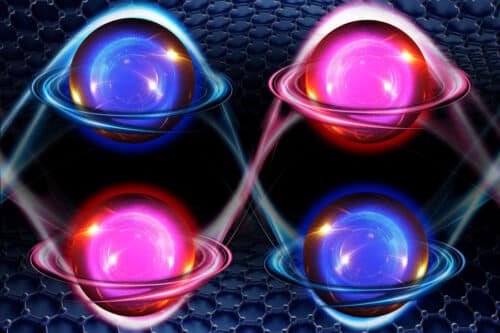A recently unearthed form of electronic behaviour could aid in increasing data storage capacity in magnetic memory devices.

Regular pencil lead possesses remarkable properties when it is carefully reduced to layers as thin as a single atom. A solitary, atomic-thin layer of graphite, or graphene, constitutes only a minute fraction of the thickness of a human hair. When observed under a microscope, this material resembles a chicken wire lattice, with carbon atoms interconnected in a hexagonal pattern. Despite its slender dimensions, researchers have discovered that graphene possesses exceptional strength over time. When layered and subjected to precise twists and contortions, this material can exhibit unexpected electronic properties.
MIT physicists have revealed that graphene is arranged in a five-layer rhombohedral pattern and exhibits a rare state called “multiferroic,” showcasing both unconventional magnetism and a unique electronic behaviour termed “ferro-valleytricity.” Each additional graphene layer reveals new properties not seen in fewer layers. This discovery could aid engineers in developing energy-efficient, high-capacity data storage for classical and quantum computers. Multiferroic properties in one material could improve magnetic hard drive writing efficiency and double data storage compared to conventional devices.
A preference for order
Ferroic materials show synchronised behaviour in their electric, magnetic, or structural properties. For example, a magnet aligns its electrons’ spins without an external field, naturally aligning in a preferred direction. Some materials display ferroic properties, but only a few are multiferroic, where multiple characteristics align in different preferred directions, similar to a magnet aligning one way. At the same time, the electric charge shifts independently in another.
Multiferroic materials offer potential in electronics by improving hard drive speed and reducing energy consumption. Unlike traditional magnetic hard drives, which use electric currents to switch tiny magnets for data storage, multiferroic materials could provide a more efficient and faster solution. The research team found that arranging five graphene layers in a rhombohedral pattern creates coordinated electron behaviour. This arrangement restricts electron mobility, prompting effective interactions and leading to preferred ferroic arrangements.
Magic flakes
Researchers conducted lab experiments to detect multiferroic behaviour in five-layer graphene. They started with a small graphite block, extracted individual flakes, and used optical methods to identify naturally occurring five-layer flakes in a rhombohedral pattern. Researchers quickly identified flakes with exactly five layers arranged in a rhombohedral pattern, causing electron motion to slow down. They isolated many such flakes and conducted experiments at near zero temperatures to minimise thermal effects. The experiments showed that electrons exhibited two distinct coordinated behaviours when subjected to electric and magnetic fields, confirming the presence of two ferroic orders.
Two Distinct Ferroic Characteristics in Graphene
In the first ferroic attribute, electrons synchronised their orbital motion, similar to planets all orbiting in the same direction, unlike conventional magnets where electrons align their spin. The second ferroic characteristic was related to graphene’s electronic “valley,” representing the lowest energy state for electrons. Graphene has two potential valleys, and electrons typically have no preference for either, distributing themselves equally between them.
However, within the context of five-layer graphene, the researchers observed that electrons started synchronising their behaviour and preferred one valley over the other. This additional coordinated behaviour signalled a ferroic characteristic that, combined with the unconventional magnetism of the electrons, bestowed upon the structure a rare and distinctive multiferroic state.
The team demonstrated their ability to manipulate ferroic properties using an electric field. They envision that if engineers can integrate five-layer graphene or similar multiferroic materials into a memory chip, it could theoretically enable the use of the same low-power electric field to manipulate the material’s electrons in two distinct ways, effectively doubling the amount of data that could be stored on a chip compared to conventional multiferroics. While this vision remains far from practical realisation, the team’s findings represent a significant advancement in pursuing more efficient electronic, magnetic, and valleytronic devices.






